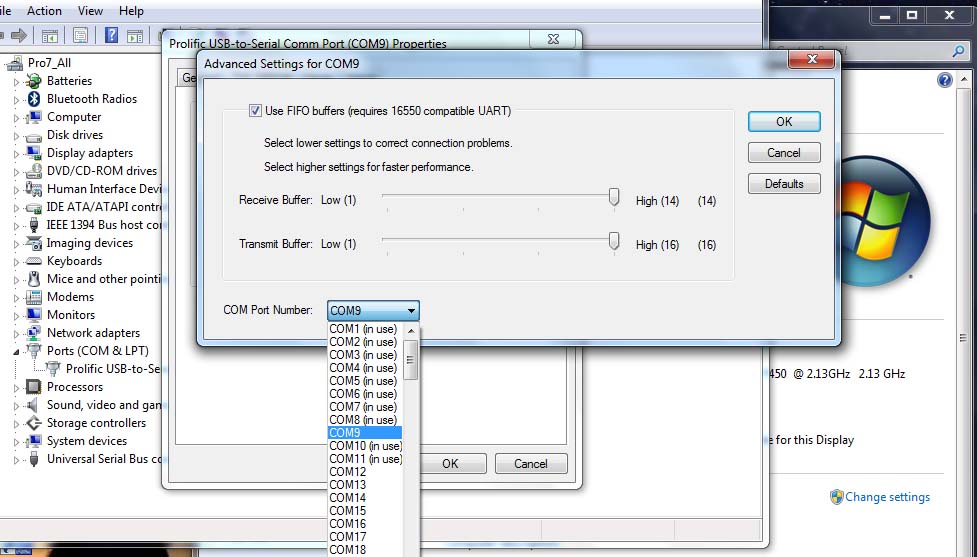
Communication Port Com1 Drivers For Mac Com1 Port Some software and specialty hardware requires you to use a traditional serial port. Serial ports have.
Mac's and serial TTY'sMac's are excellent tools for accessing serial device TTY ports (to console into PBX's, switches, and routers). Note: Check your adapter works after an OS Update, as you may have to re-install the driver.You might notice that each serial device shows up twice in /dev, once as a tty. and once as a cu. So, what's the difference? Well, TTY devices are for calling into UNIX systems, whereas CU (Call-Up) devices are for calling out from them (eg, modems). We want to call-out from our Mac, so /dev/cu.
is the correct device to use.The technical difference is that /dev/tty. devices will wait (or listen) for DCD (data-carrier-detect), eg, someone calling in, before responding.
/dev/cu. devices do not assert DCD, so they will always connect (respond or succeed) immediately.Software:Having installed the right driver, our USB-Serial adapter will show up in /dev/cu. (shown above). We now need to install some terminal emulation software before we can connect to anything. Two terminal methods are and.
For a GUI solution, seeNote: If you can't find a driver for your adapter (eg, Belkin), try which has built-in support for many USB-Serial devices.ScreenIt's not actually necessary to download an install extra software, as you can use the Mac OS X built in Terminal and screen. Screen lacks some features, but it does include VT100/ANSI terminal emulation, and can be extremely useful. Open an OS X terminal session (window).
Find the right TTY device. Type: ls /dev/cu.With the USB-Serial adapter plugged in, you'll get a list, including something like this:$ ls /dev/cu./dev/cu.Bluetooth-Modem /dev/cu.iPhone-WirelessiAP/dev/cu.Bluetooth-PDA-Sync/dev/cu.usbserial. Then type: screen /dev/cu.usbserial 9600 (in this example).The 9600 at the end is the baud rate. You can use any standard rate,eg, 9600, or 19200 for a Sig Server!. To quit the screen app, type CTRL-A, then CTRL.Type man screen in Terminal for further information on screen.
Command SummaryIn minicom, commands can be called by CTRL-A, for example, change your serial port settings with CTRL-A PPress CTRL-A Z for a Command Summary, and help on special keys. Enter CTRL-A X to quit.HINT: Change your OS X terminal window size to 80x25 (1 line more) so you can see the bottom Minicom status bar.(Terminal Preferences ► Settings ► Window). Open a new window for this change to take effect.Note, the minicom installer creates /opt, and its not hidden in the OS X finder. Rectify this with: sudo chflags hidden /opt ConnectingWith handshaking set to software ( xon/xoff) or none, which covers most devices, serial data communication needs just 3 wires: RXD (2), TXD (3), and GND (5).
Kodak Preps 8.4.0 Build 128 (Win/Mac) Free Download Kodak Preps 8 is available as a free download from our software library. Imposition is at the heart of off-set production costs – affecting throughput, material usage, and labor.  Preps is the imposition tool of choice in the commercial printing industry, providing the flexibility needed to build a workflow that suits your unique requirements. Preps can impose any combination of PostScript, PDF, EPS, DCS, and TIFF source files into signatures, eliminating the need for manual stripping. Download Kodak Preps 8.4 for Mac free latest version offline setup for macOS. Kodak Preps 8.4 for Mac is a powerful application for the printing industry with a variety of powerful tools and a bundle of powerful tools that enhances the workflow and provides more accurate impositions.
Preps is the imposition tool of choice in the commercial printing industry, providing the flexibility needed to build a workflow that suits your unique requirements. Preps can impose any combination of PostScript, PDF, EPS, DCS, and TIFF source files into signatures, eliminating the need for manual stripping. Download Kodak Preps 8.4 for Mac free latest version offline setup for macOS. Kodak Preps 8.4 for Mac is a powerful application for the printing industry with a variety of powerful tools and a bundle of powerful tools that enhances the workflow and provides more accurate impositions.
Generally, hitting should cause a response, or should 're-draw' the screen. If you don't get any characters, try adding a Null-Modem cable or adapter, which swaps RXD and TXD (pins 2 and 3). Signal ground is Pin 5 in a DB-9, or Pin 7 in a DB-25.Pin Functions for RS-232 DataTXD(3)Serial Data OutputRXD(2)Serial Data InputGND(5)Signal GroundOtherRI(9)Ring IndicatorHandshakeRTS(7)Request to SendCTS(8)Clear to SendDSR(6)Data Set ReadyDCD(1)Data Carrier DetectDTR(4)Data Terminal ReadyDB-9 MaleFront (pin) view.

CrossOver can't connect directly to hardware ports or devices on your computer. This can cause problems if the Windows program you're trying to use needs to communicate with a USB device. A potential workaround is to manually map a device entry from the native OS to a symlink in the bottle containing your Windows app, and then hope that the Windows app sees the COM port and can use it to connect to the device.
The first thing you need to do is discover which /dev entry is being created when you connect the USB device to the computer. Disconnect the device from your computer and run the following commands in a Terminal:
Connect the device, wait a moment for your computer to recognize it, and run the command:
Now compare the difference between the two file listings to see what /dev entry was created.
If there is a new device entry listed use that name as (device-entry) in the following steps.
Mac OS:
Linux:
With luck your Windows program should now be able to use COM1 to access the USB device.
Please remember that we don't officially support any programs that use serial ports. If you're still having trouble getting your application to work we may be able to do custom programming for your application to get it connected. Contact sales@codeweavers.com for more information and mention that you've already tried these steps.